What does this look like in the classroom
Listen to these …prominent educators showcase scientifically researched evidence-based methods including explicit instruction and the ‘Big 6’ of Reading. Research indicates that a building a bridge between oral language and written language facilitates reading acquisition. The effective teaching of reading encompasses oral language, phonological and phonemic awareness, phonics, fluency, vocabulary and comprehension.
Outside the Square Film 3 – The Explicit Teaching of Language and Literacy (2017)
Links to further Outside the Square videos
Outside the Square – Film 1 – Understanding and Identifying Dyslexia
Outside the Square Film 2 – Targeted Teaching for Students with Dyslexia
Examples of Planning
The following resources have been generously shared amongst Education Communities, Science of Learning and Science of Reading communities.
I have attached a link to a collated resource that Brendan Lee, (Learning with Mr. Lee) created.
I have added additional links and resources for your reference.
You can access Brendan Lee’s website via the following link.
- What does the Science of Reading actually look like in the classroom? – Learning with Mr. Lee
- How should we actually teach Primary English?
- Why should we follow the Science of Reading?
Scope and Sequence examples
The Reading Science in Schools (a community of educators offering advice, support and resources to support the implementation of the Science of Reading in Schools) facebook site has been archived, however resources are still available. Facebook Group
Mosman Park Primary School Phonics Scope and Sequence
PhOrMeS Is a free primary word reading, spelling and learning curriculum that was created at Brandon Park Primary School. It is a ready-to-teach, comprehensive, core literacy skills curriculum which covers the key language and literacy skills of:
- Phonology through phonics
- Orthography – correct spelling
- Morphology andEtymology
- Semantics
Cognitorium | Teaching all facets of literacy — Dr Nathaniel Swain
Serpentine Primary School Instructional Playbook | Serpentine PS
Grace Mary Primary School – Curriculum
Core Knowledge Language Arts, from E.D. Hirsch’s team.
Language Arts – Core Knowledge Foundation
Does Core Knowledge Work Does core knowledge work? | Filling the pail
UFLI Foundations Toolbox: The Toolbox contains resources to support your implementation of UFLI Foundations lessons. These include lesson slide decks, decodable passages, and more!
Tennessee Foundational Skills Curriculum Supplement Resources: “This supplement is completely free, optional, and uses a systematic and explicit approach to sounds-first instruction to help all students gain the foundational skills necessary to become proficient readers. Teachers, districts, and parents can access and download the materials in the supplement at any time. These resources include teacher guides, student workbooks, and practice activities to help early learners focus on phonemic awareness, vocabulary, and fluency.”
Reading Rockets –Phonics: In Practice
Five from Five – Scope and Sequence
SPELD NSW – Phonics and Morphology Scope and Sequence
SPELD – Vocabulary Scope and Sequence
Dr. Anita Archer – Series of videos of her demonstrating explicit instructional lessons.
- “Teach the stuff and cut the fluff”
- “Learning is the outcome, teaching is the pathway”
- “If you expect it, pre-correct it”
- “Avoid the void, for they will fill it”
- “Predictability, predicts ability”
Podcast – Ollie Lovell ERRR#060. Anita Archer on Explicit Instruction
ERRR #060. Anita Archer on Explicit Instruction. | Ollie Lovell
Kelly Buxton from Courthouse Juniour (UK)- Reading strategy updated
Emina McLean – Working the clock and “the literacy block”. Emina also presented Designing an ambitious and rigorous primary English curriculum where she outlines Dockland PS curriculum design process and what it looks like. She uses 5 “Big Idea’s” as a guide:
- Be Ambitious: “Students are capable of far more than we give them credit for. We should aim high(er).”
- Be rigorous: “Teaching is hard. Learning is hard. We plan supports for staff and students accordingly”
- Expertise, equity, workload v. autonomy: Develop teacher expertise, low variance curriculum, mapped and aligned curriculum, clear scope and sequence documents, high quality materials.
- Viewing English and Literacy as synonymous can be unhelpful: Literacy is seen as being taught in a block then it’s done. It is never done.
- Integrated instruction > isolated instruction: Focused attention on building foundational (core) literacy skills without the distraction of content is a useful approach initially.
Examples of Literacy Blocks
As you are aware there are a multitude of literacy block examples and there is no one way to structure your literacy block.
Whilst we must ensure that the curriculum content and pedagogical practices, we use are evidence and research based, we must also ensure that the content is organised in a detailed scope and sequence and that we use a structured literacy approach that is explicit, systematic, sequential, cumulative and responsive to student needs.
For your reference, I have compiled several examples and links to further quality resources.
Tim Shanahan – How Would You Schedule the Reading Instruction?
Recommends 2-3 hours/day of reading/writing instruction. “Need instruction in multiple areas: word knowledge, oral reading fluency, writing, and reading comprehension.” Also, he writes about how it doesn’t all have to be in the one block.
Jocelyn Seamer – The What, Why and How Long of the Literacy Block:
- Daily Review – approximately 15 minutes
- Explicit Teaching of graphemes and word level skills (25 min)
- Sentence Level Transcription (15 min)
- Decoding and Reading (20 min)
- Shared Writing (15-20 min)
- Language and Literature Based Lesson (30-40 min)
Nathaniel Swain:Teaching all the facets of reading and writing – Prep/Kindy
Oral Language and Comprehension – 20min Language Arts – Core Knowledge Foundation
Decoding & Encoding
- Phonemic Awareness – 3 min
- Decoding & Spelling review – 10 min
- NEW Decoding & Spelling – 17min
- Additional component Reading Fluency – 10min
Handwriting – 10min
Vocabulary & Morphology – 10min
Oral Sentence Composition – Writing revolution / Reading Science Syntax Scope & Sequence (modified)
Clayton South Primary School
- You can read about their structured literacy program
SPELD NSW Literacy Block with Retrieval Practice (2024) Literacy Block
Reading Science in Schools – Rethinking Guided Reading Sharing Best Practice Perth
- Facebook Group (resources achieved)
- https://youtu.be/-lng9j47Zf8
- https://youtu.be/-lng9j47Zf8?si=MTGcY5akD0yp9KJM
- https://youtu.be/-lng9j47Zf8?si=xQC-8ji6HzXW_ziD
Natalie Campbell (Reading Science in Schools): Setting up Literacy Routines i.e. phonics work, using SA Speld decodables, word level reading, Daily Review)
https://youtu.be/lCqHpMHD32E?si=PtEgDetkDKsSO2TS
Note:
- SPELD New Decodables https://www.speldsa.org.au/SPELD-SA-P…
- SIT Booklet https://drive.google.com/file/d/18i6k…
- PPT Printing animations https://docs.google.com/presentation/…
Steph Le Lievre – Guided Reading: an alternative approach.
- Literacy daily review – 20min
- Whole class phonics/spelling lesson – 20min
- Fluency pairs – 10min
- Comprehension – 30min
- Writing – 30min
- Handwriting – 10min
Serpentine State Primary School Instructional Playbook (WA)
Principal, Stephanie Le Lievre and her team have generously shared their curriculum and pedagogical playbook. This playbook is comprised of the high-quality evidence-based approaches to instruction. Their philosophy is grounded in the Science of Learning, ensuring that teaching methods are supported by research and proven to be effective. They have prioritise knowledge-rich curriculum and have a Multi-Tiered Support System (Response to Intervention model).
Link for your reference fae298_b63fc3a3624543ce91007269a0702425.pdf
Planning Examples below: Serpentine State Primary School
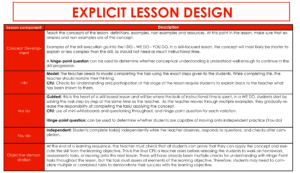
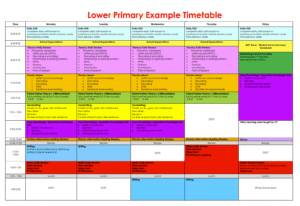
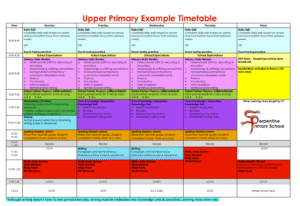
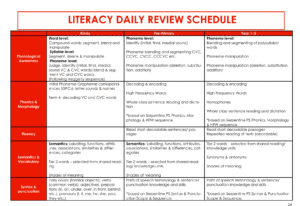
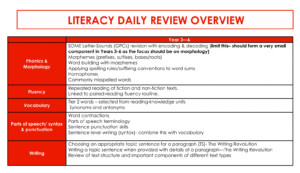
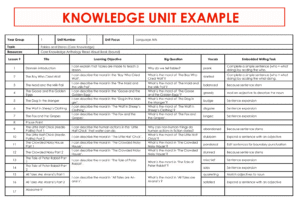
And More Examples
Walk to Read Model & Data Driven Schedules
- Differentiation Done Right: How “Walk to Read” Works | Reading Rockets
- What Does Your Literacy Block Look Like? It Depends. | Reading Rockets
- What does your literacy block look like? It depends…
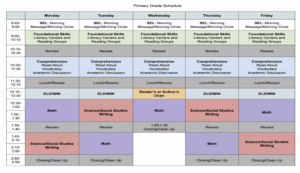
Lower Primary Literacy Block
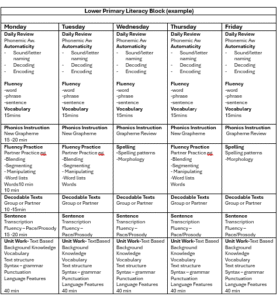
Phonics Lesson Structure
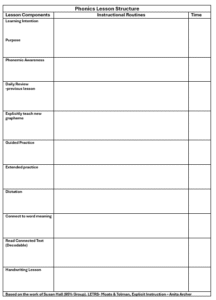
Comprehension Planner – Before Reading
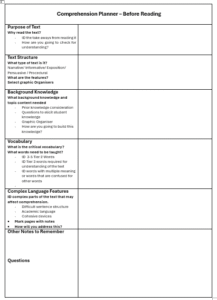
Small Group Intervention (Modify as required)
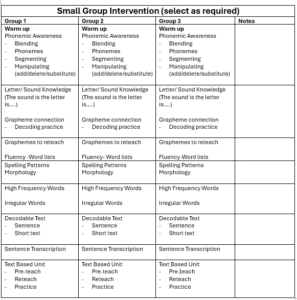
Upper Primary Literacy Block
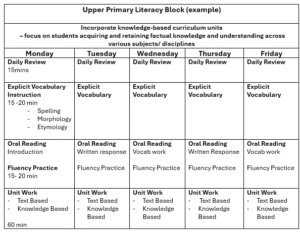
Listen to Joscelyn Seamer talk about planning for the Upper Primary Literacy Block in her Summer Series Podcast
Joscelyn Seamer Education
S1 E8 – What goes into the Upper Primary Literacy Block?
Knowledge, Execution and Structure. The keys to Reading SUCCESS for ALL | Learning MATTERS
AuthenticTextLessonPlan-Years2-4PrefilledExample.pdf
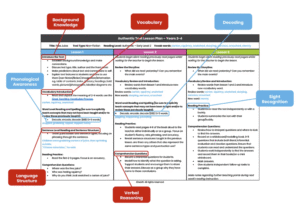
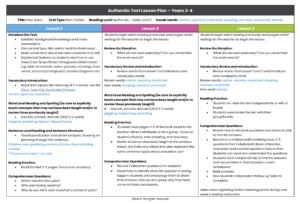
Lesson Plan examples
Think Forward Educators – Read2Learn Units
AERO Welcome to AERO | Australian Education Research Organisation
OCHRE Ochre resources | Australian Education Research Organisation
ARC Victorian Education Department
- Arc
- Arc: Supporting Victorian teachers | Department of Education
- Phonics Plus scope and sequence | Lesson plans guidance | Arc
- Lesson plans | Arc
Designing English Curriculum
Emina McLean: Designing an ambitious and rigorous primary English curriculum
Pedagogy
AERO Evidence Based Practices
2024 ACER Publications and resources – ACER
The Literacy Hub – Australian Government Department of Education (links to resources)
- Literacy Hub
- Planning resources
- Year 1 Phonics Check
- Phonics and morphology lesson packs for teachers
- Student learning support
